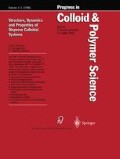Abstract
Traditional approaches to ground water remediation have proven ineffective, especially when trapped oil phases exist. Surfactants are being widely evaluated to enhance remediation of such ground water contamination episodes. Successful implementation of surfactant enhanced subsurface remediation requires careful consideration of fundamental surfactant properties. The economic viability of this technology requires targeting the residual contamination, minimizing surfactant losses, and recovery and reuse of the surfactant. The relative efficiencies and advantages of surfactant solubilization and mobilization systems are described, as well as means to optimize these systems. Unit processes for contaminant-surfactant separation and surfactant reuse are summarized, along with unique surfactant impacts on these separation processes. Factors affecting the environmental acceptability of surfactants are discussed. Finally, results of field demonstrations are presented that reinforce concepts presented. This study thus provides an introduction to surfactant chemistry and highlights key factors critical to the successful design and implementation of surfactant enhanced subsurface remediation systems.
Preview
Unable to display preview. Download preview PDF.
References
Rosen MJ (1989) Surfactants and interfacial phenomena, 2nd ed. Wiley, New York, NY
Edwards D, Luthy R, Liu Z (1991) Envir Sci Tech 25(1):127–133
Shiau B, Sabatini D, Harwell J (1994) Ground Water 32(4):561–569
Pope G, Wade W (1995) in: Surfactant-enhanced subsurface remediation: Emerging technologies. Sabatini D, Knox R, Harwell J (eds) ACS Symp Ser 594. American Chemical Society, Washington DC, 142–160
Bourrel M, Schechter R (1988) Microemulsions and related systems. Surfactant science series, Vol 30. Marcel Dekker, New York
West C, Harwell J (1992) Envir Sci Tech 26:2324–2330
Pennel K, Abriola L, Weber W (1993) Envir Sci Tech 27(12):2341–2351
Baran J, Pope G, Wade W, Weerasooriyaa V, Yapa A (1994) Envir Sci Tech 28(7):1361–1366
Fountain J, Waddell-Sheets C, Lagowski A, Taylor C, Frazier Byrne M (1995) in: Surfactant-enhanced subsurface remediation: Emerging technologies. Sabatini D, Knox R, Harwell J (eds) ACS Symp Ser 594. American Chemical Society, Washington DC, 177–190
Sabatini D, Knox R, Harwell J (eds) (1995) Surfactant enhanced subsurface remediation: Emerging technologies. ACS Symp Ser 594. American Chemical Society, Washington DC
Krebs-Yuill B, Harwell J, Sabatini D, Knox R (1995) in: Surfactant-enhanced subsurface remediation: Emerging technologies. Sabatini D, Knox R, Harwell J (eds) American Chemical Society, Washington DC
Krebs-Yuill B, Harwell J, Sabatini D, Quinton G, Shoemaker S (1996) Economic study of surfactant-enhanced pump-and-treat remediation. 69th Annual Water Envir Federation Conf, Dallas, Texas, 5–9 October
Rouse J, Sabatini D, Harwell J (1993) Envir Sci Tech 27(10):2072–2078
Rouse J, Sabatini D, Brown R, Harwell J (1996) Water Envir Res 68(2):162–168
Shiau B, Sabatini D, Harwell J, Vu (1996) Envir Sci Tech 30(1):97–103
Nayyar S, Sabatini D, Harwell J (1994) Envir Sci Tech 28:1874–1881
Rouse J, Sabatini D, Deeds N, Brown E, Harwell J (1995) Envir Sci Tech 29(10):2484–2489
Shiau B, Sabatini D, Harwell J (1997) Removal of chlorinated solvents in subsurface media using edible surfactants: column studies. J Envir Engr Div ASCE (in review)
Lipe M, Sabatini D, Hasegawa M, Harwell J (1996) Ground Water Monit Remed 16(1):85–92
Hasegawa M, Sabatini D, Harwell J (1997) J Envir Engr Div ASCE 123(7):691–697
Knox R, Sabatini D, Harwell J, Brown E, West C, Blaha F, Griffin C (1997) Surfactant remediation field demonstration using a vertical circulation well. Ground Water 35(6):948–953
Author information
Authors and Affiliations
Editor information
Rights and permissions
Copyright information
© 1998 Dr. Dietrich Steinkopff Verlag GmbH & Co. KG
About this paper
Cite this paper
Sabatini, D.A., Knox, R.C., Harwell, J.H. (1998). Surfactant selection criteria for enhanced subsurface remediation: Laboratory and field observations. In: Rehage, H., Peschel, G. (eds) Structure, Dynamics and Properties of Disperse Colloidal Systems. Progress in Colloid & Polymer Science, vol 111. Steinkopff. https://doi.org/10.1007/BFb0118127
Download citation
DOI: https://doi.org/10.1007/BFb0118127
Published:
Publisher Name: Steinkopff
Print ISBN: 978-3-7985-1118-7
Online ISBN: 978-3-7985-1652-6
eBook Packages: Springer Book Archive

